air conditioning DODGE DART 2015 PF / 1.G User Guide
[x] Cancel search | Manufacturer: DODGE, Model Year: 2015, Model line: DART, Model: DODGE DART 2015 PF / 1.GPages: 664, PDF Size: 16.96 MB
Page 524 of 664
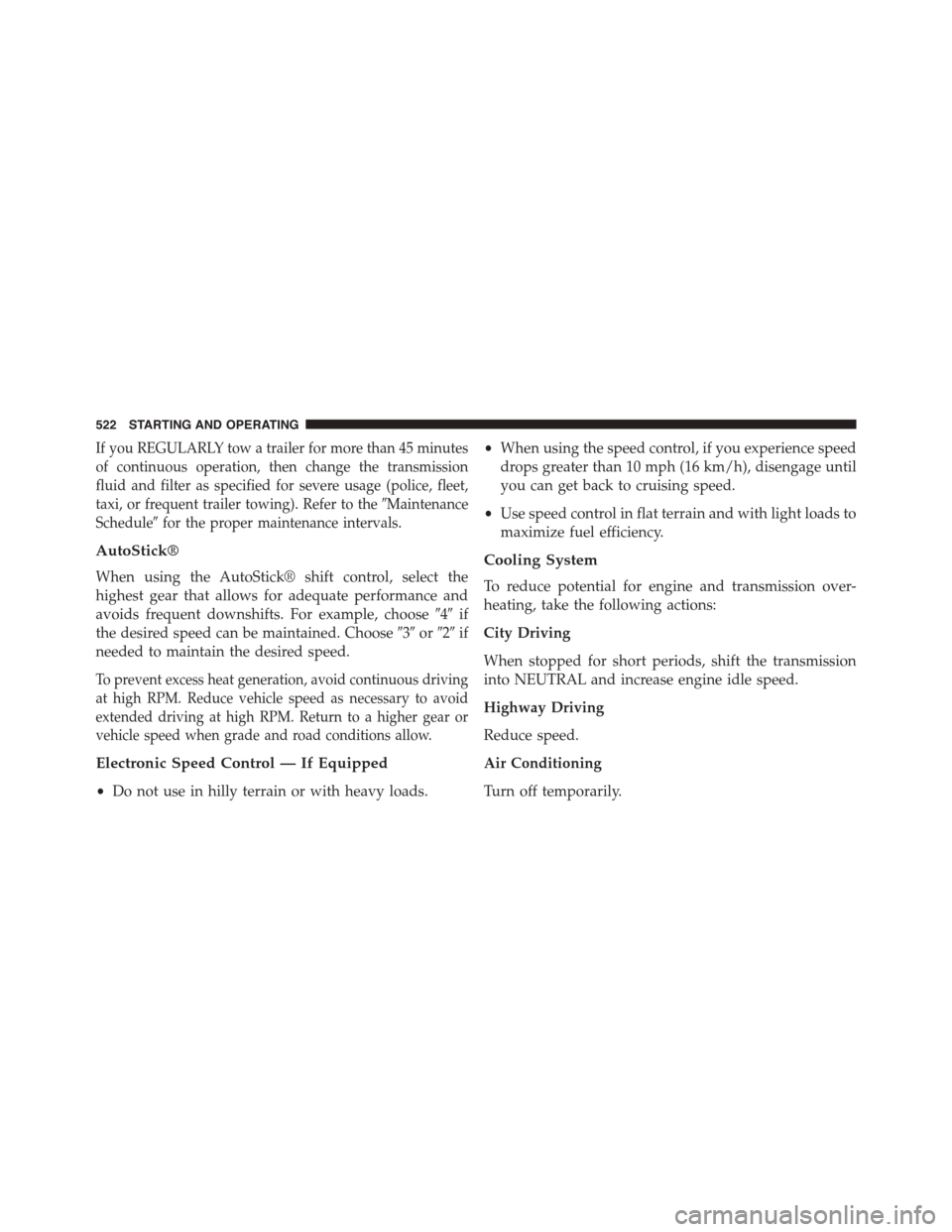
If you REGULARLY tow a trailer for more than 45 minutes
of continuous operation, then change the transmission
fluid and filter as specified for severe usage (police, fleet,
taxi, or frequent trailer towing). Refer to the#Maintenance
Schedule#for the proper maintenance intervals.
AutoStick®
When using the AutoStick® shift control, select the
highest gear that allows for adequate performance and
avoids frequent downshifts. For example, choose#4#if
the desired speed can be maintained. Choose#3#or#2#if
needed to maintain the desired speed.
To prevent excess heat generation, avoid continuous driving
at high RPM. Reduce vehicle speed as necessary to avoid
extended driving at high RPM. Return to a higher gear or
vehicle speed when grade and road conditions allow.
Electronic Speed Control — If Equipped
•Do not use in hilly terrain or with heavy loads.
•When using the speed control, if you experience speed
drops greater than 10 mph (16 km/h), disengage until
you can get back to cruising speed.
•Use speed control in flat terrain and with light loads to
maximize fuel efficiency.
Cooling System
To reduce potential for engine and transmission over-
heating, take the following actions:
City Driving
When stopped for short periods, shift the transmission
into NEUTRAL and increase engine idle speed.
Highway Driving
Reduce speed.
Air Conditioning
Turn off temporarily.
522 STARTING AND OPERATING
Page 574 of 664
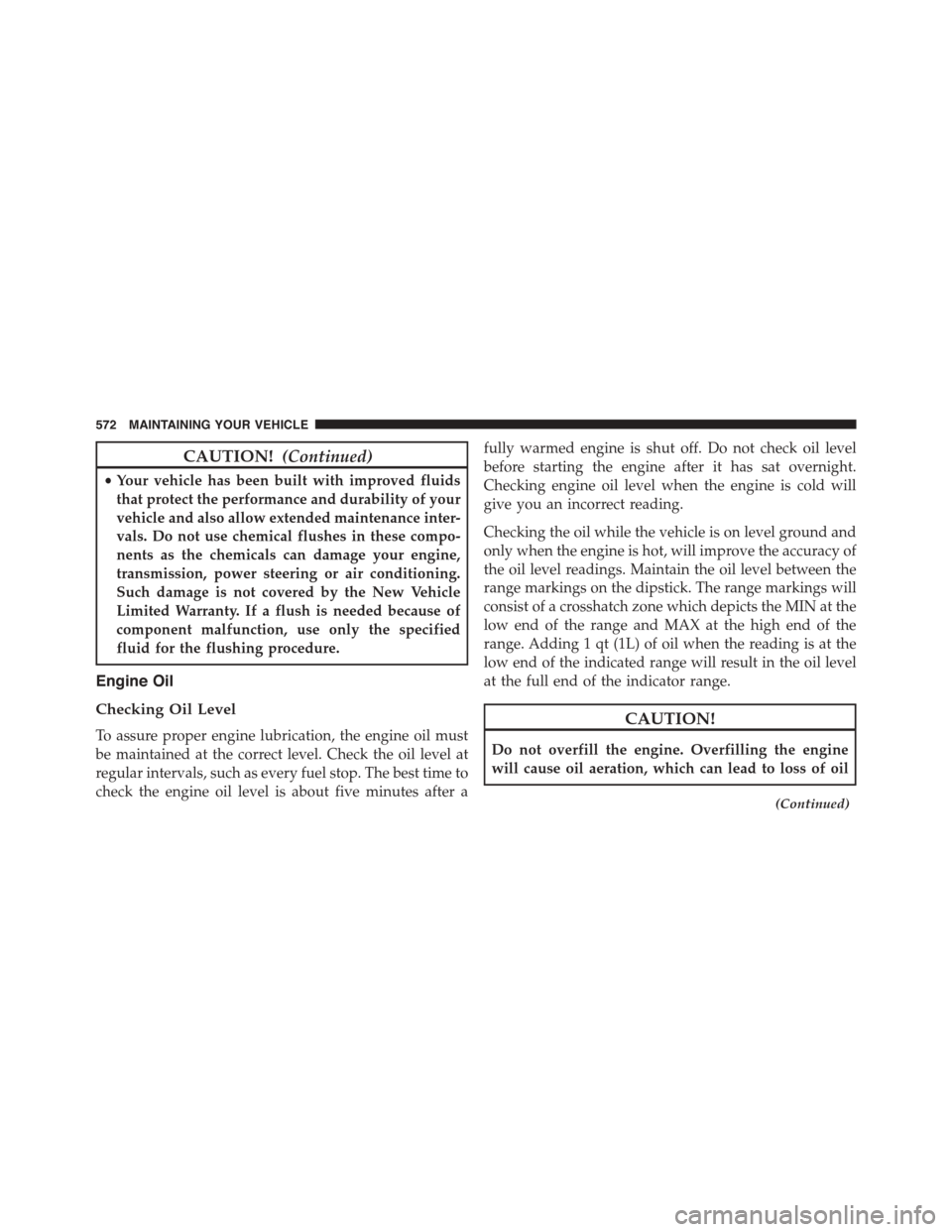
CAUTION!(Continued)
•Your vehicle has been built with improved fluids
that protect the performance and durability of your
vehicle and also allow extended maintenance inter-
vals. Do not use chemical flushes in these compo-
nents as the chemicals can damage your engine,
transmission, power steering or air conditioning.
Such damage is not covered by the New Vehicle
Limited Warranty. If a flush is needed because of
component malfunction, use only the specified
fluid for the flushing procedure.
Engine Oil
Checking Oil Level
To assure proper engine lubrication, the engine oil must
be maintained at the correct level. Check the oil level at
regular intervals, such as every fuel stop. The best time to
check the engine oil level is about five minutes after a
fully warmed engine is shut off. Do not check oil level
before starting the engine after it has sat overnight.
Checking engine oil level when the engine is cold will
give you an incorrect reading.
Checking the oil while the vehicle is on level ground and
only when the engine is hot, will improve the accuracy of
the oil level readings. Maintain the oil level between the
range markings on the dipstick. The range markings will
consist of a crosshatch zone which depicts the MIN at the
low end of the range and MAX at the high end of the
range. Adding 1 qt (1L) of oil when the reading is at the
low end of the indicated range will result in the oil level
at the full end of the indicator range.
CAUTION!
Do not overfill the engine. Overfilling the engine
will cause oil aeration, which can lead to loss of oil
(Continued)
572 MAINTAINING YOUR VEHICLE
Page 580 of 664
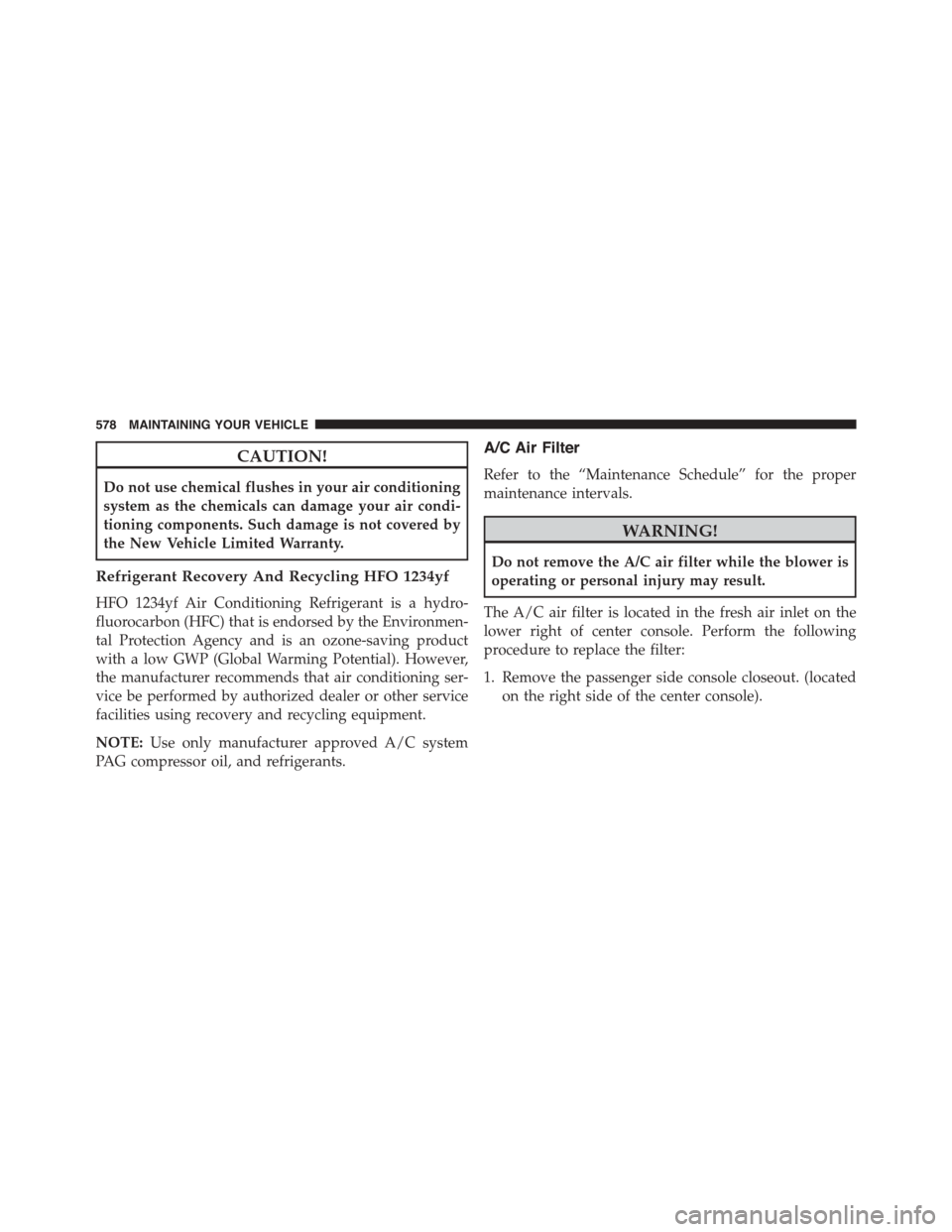
CAUTION!
Do not use chemical flushes in your air conditioning
system as the chemicals can damage your air condi-
tioning components. Such damage is not covered by
the New Vehicle Limited Warranty.
Refrigerant Recovery And Recycling HFO 1234yf
HFO 1234yf Air Conditioning Refrigerant is a hydro-
fluorocarbon (HFC) that is endorsed by the Environmen-
tal Protection Agency and is an ozone-saving product
with a low GWP (Global Warming Potential). However,
the manufacturer recommends that air conditioning ser-
vice be performed by authorized dealer or other service
facilities using recovery and recycling equipment.
NOTE:Use only manufacturer approved A/C system
PAG compressor oil, and refrigerants.
A/C Air Filter
Refer to the “Maintenance Schedule” for the proper
maintenance intervals.
WARNING!
Do not remove the A/C air filter while the blower is
operating or personal injury may result.
The A/C air filter is located in the fresh air inlet on the
lower right of center console. Perform the following
procedure to replace the filter:
1. Remove the passenger side console closeout. (located
on the right side of the center console).
578 MAINTAINING YOUR VEHICLE
Page 582 of 664
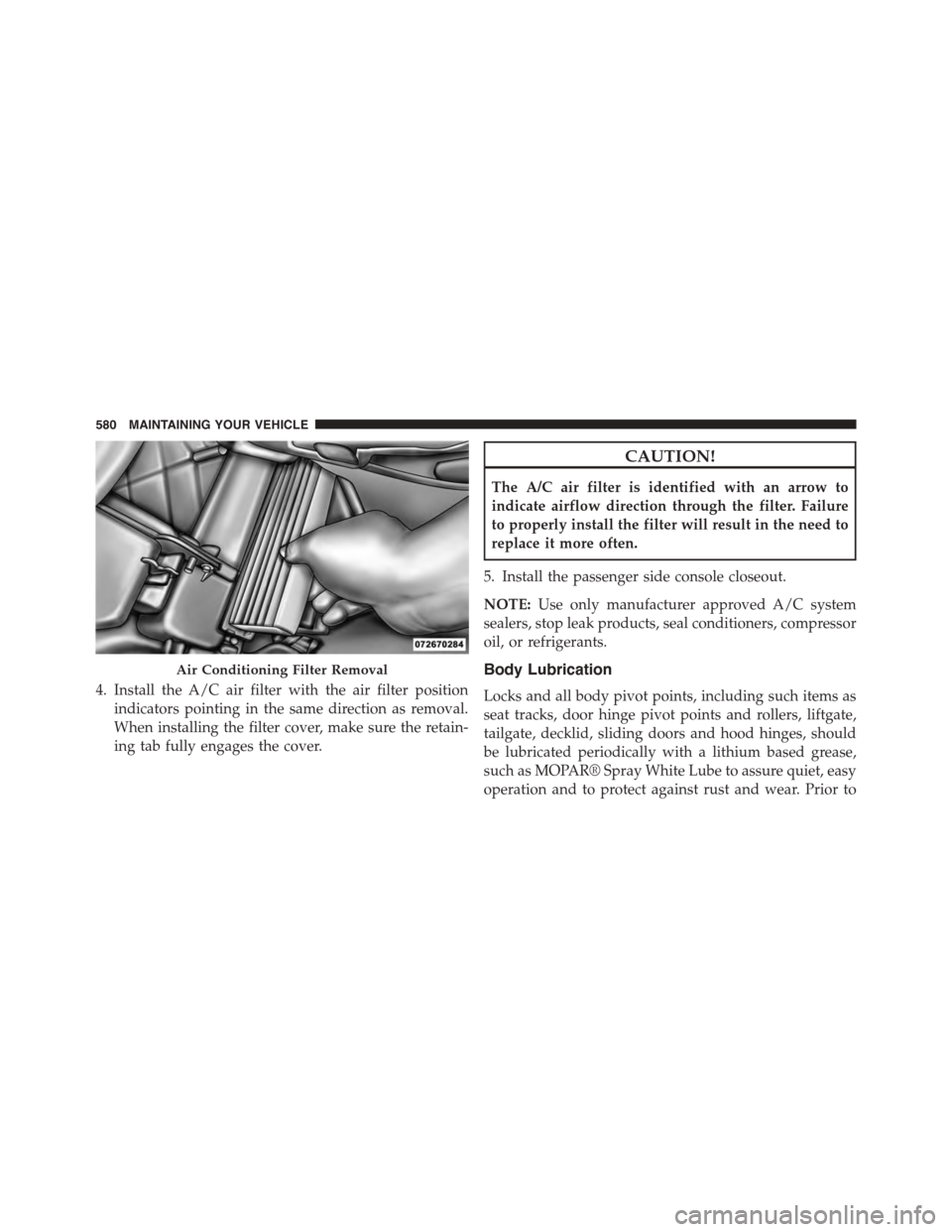
4. Install the A/C air filter with the air filter position
indicators pointing in the same direction as removal.
When installing the filter cover, make sure the retain-
ing tab fully engages the cover.
CAUTION!
The A/C air filter is identified with an arrow to
indicate airflow direction through the filter. Failure
to properly install the filter will result in the need to
replace it more often.
5. Install the passenger side console closeout.
NOTE:Use only manufacturer approved A/C system
sealers, stop leak products, seal conditioners, compressor
oil, or refrigerants.
Body Lubrication
Locks and all body pivot points, including such items as
seat tracks, door hinge pivot points and rollers, liftgate,
tailgate, decklid, sliding doors and hood hinges, should
be lubricated periodically with a lithium based grease,
such as MOPAR® Spray White Lube to assure quiet, easy
operation and to protect against rust and wear. Prior to
Air Conditioning Filter Removal
580 MAINTAINING YOUR VEHICLE
Page 592 of 664
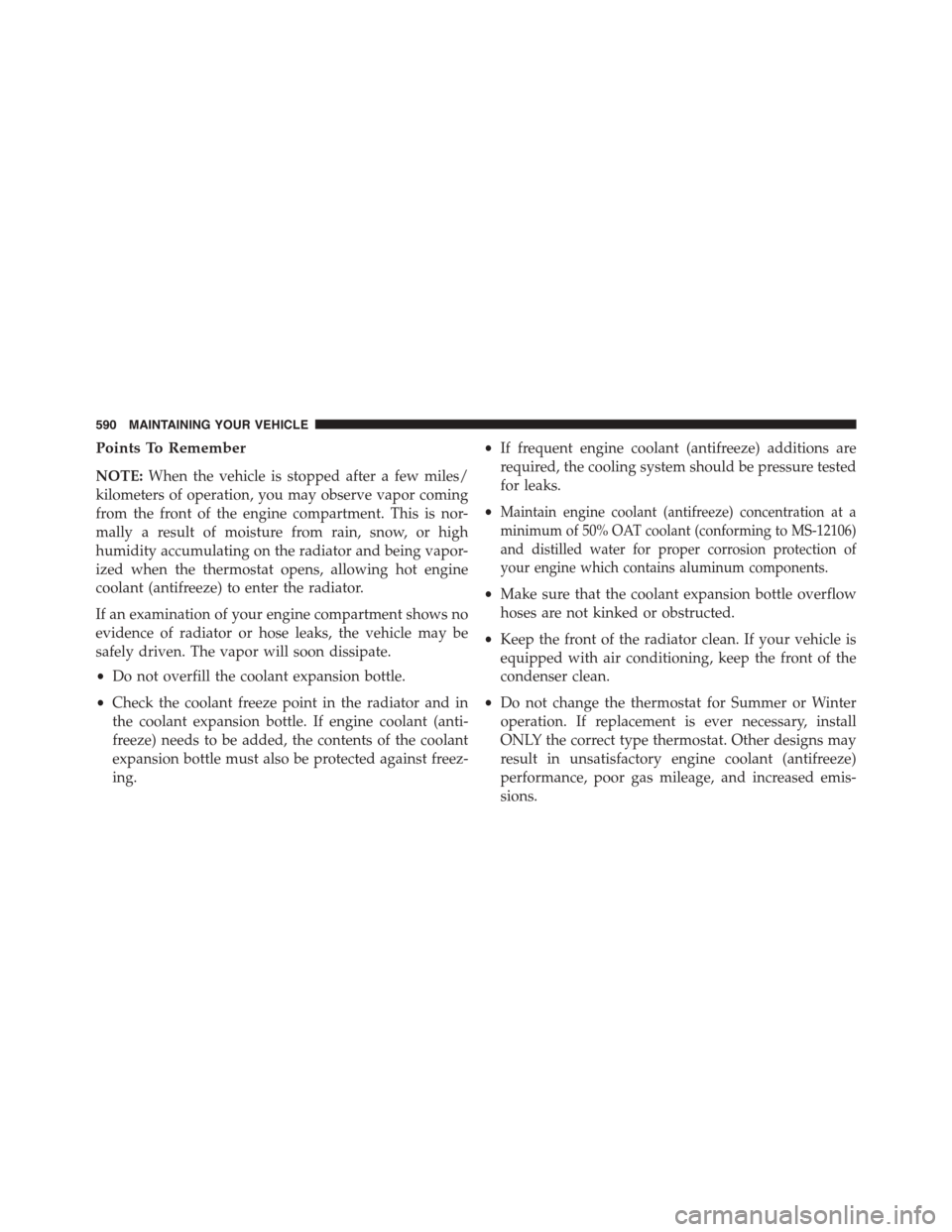
Points To Remember
NOTE:When the vehicle is stopped after a few miles/
kilometers of operation, you may observe vapor coming
from the front of the engine compartment. This is nor-
mally a result of moisture from rain, snow, or high
humidity accumulating on the radiator and being vapor-
ized when the thermostat opens, allowing hot engine
coolant (antifreeze) to enter the radiator.
If an examination of your engine compartment shows no
evidence of radiator or hose leaks, the vehicle may be
safely driven. The vapor will soon dissipate.
•Do not overfill the coolant expansion bottle.
•Check the coolant freeze point in the radiator and in
the coolant expansion bottle. If engine coolant (anti-
freeze) needs to be added, the contents of the coolant
expansion bottle must also be protected against freez-
ing.
•If frequent engine coolant (antifreeze) additions are
required, the cooling system should be pressure tested
for leaks.
•Maintain engine coolant (antifreeze) concentration at a
minimum of 50% OAT coolant (conforming to MS-12106)
and distilled water for proper corrosion protection of
your engine which contains aluminum components.
•Make sure that the coolant expansion bottle overflow
hoses are not kinked or obstructed.
•Keep the front of the radiator clean. If your vehicle is
equipped with air conditioning, keep the front of the
condenser clean.
•Do not change the thermostat for Summer or Winter
operation. If replacement is ever necessary, install
ONLY the correct type thermostat. Other designs may
result in unsatisfactory engine coolant (antifreeze)
performance, poor gas mileage, and increased emis-
sions.
590 MAINTAINING YOUR VEHICLE
Page 611 of 664

VEHICLE STORAGE
If you will not be using your vehicle for more than 21 days,
you may want to take steps to preserve your battery.
•Disconnect the negative cable from the battery.
•Anytime you store your vehicle, or keep it out of service
(i.e., vacation) for two weeks or more, run the air
conditioning system at idle for about five minutes in the
fresh air and high blower setting. This will ensure
adequate system lubrication to minimize the possibility
of compressor damage when the system is started again.
NOTE:When the vehicle has not been started or driven
for at least 35 days, an Extended Park Start Procedure is
required to start the vehicle. Refer to “Starting Procedures”
in “Starting And Operating” for further information.
REPLACEMENT BULBS
Interior Bulbs
Bulb Number
Dome LampW5W
Overhead Console LampW5W
7
MAINTAINING YOUR VEHICLE 609
Page 626 of 664
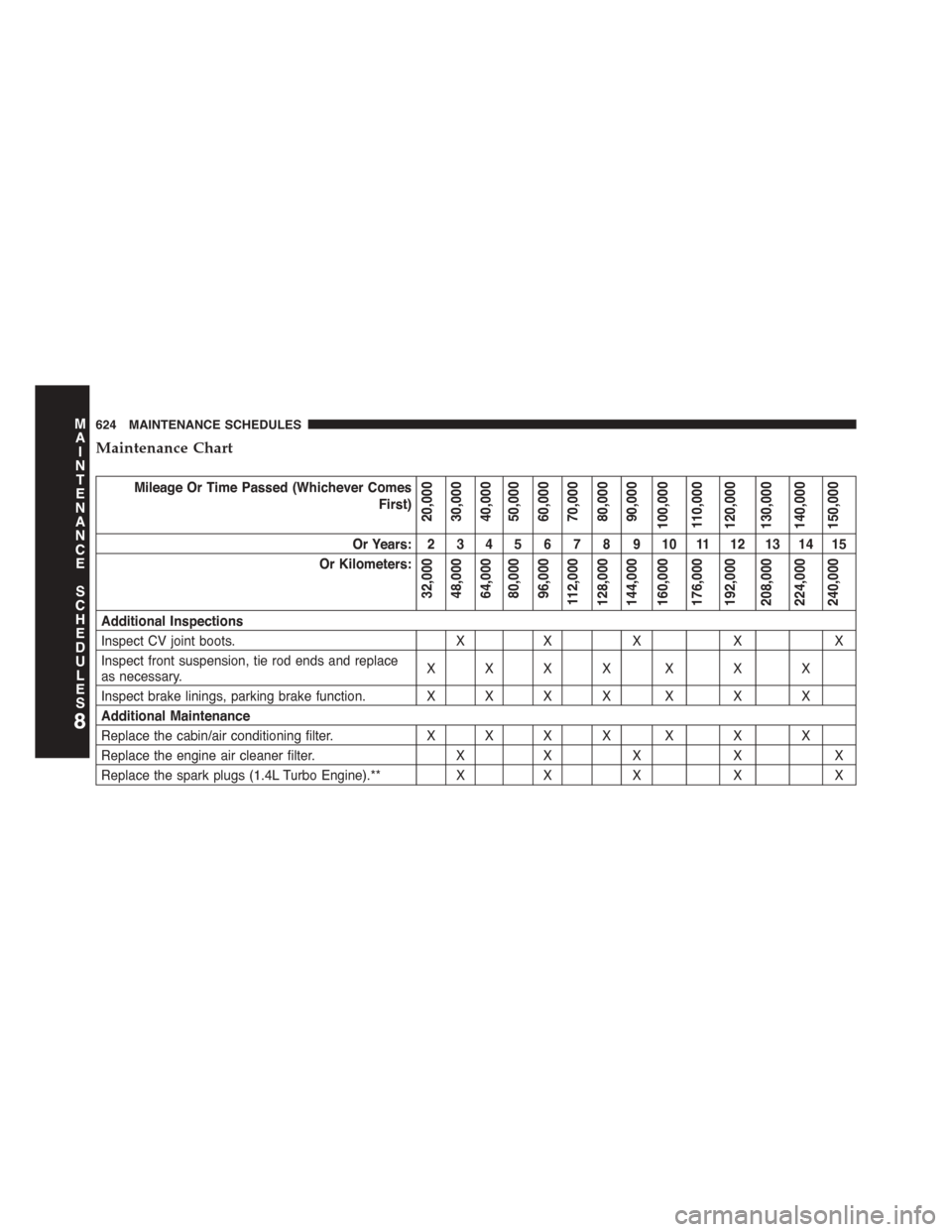
Maintenance Chart
Mileage Or Time Passed (Whichever Comes
First)20,00030,00040,00050,00060,00070,00080,00090,000100,000110,000120,000130,000140,000150,000
Or Years: 2 3 4 5 6 7 8 9 10 11 12 13 14 15
Or Kilometers:
32,00048,00064,00080,00096,000112,000128,000144,000160,000176,000192,000208,000224,000240,000
Additional Inspections
Inspect CV joint boots.XXXXX
Inspect front suspension, tie rod ends and replaceas necessary.XXX X X X X
Inspect brake linings, parking brake function. X X X X X X X
Additional Maintenance
Replace the cabin/air conditioning filter.XXX X X X X
Replace the engine air cleaner filter.XXXXX
Replace the spark plugs (1.4L Turbo Engine).**XXXXX
8
MAINTENANCE
SCHEDULES
624 MAINTENANCE SCHEDULES
Page 642 of 664

About Your Brakes........................450
ABS (Anti-Lock Brake System)................453
Adding Engine Coolant (Antifreeze)............587
Adding Fuel.............................505
Adding Washer Fluid......................581
Additives, Fuel...........................503
Air bag . . . . . . . . . . . . . . . . . . . . . . . . . . . . . . . . .62
Air Bag
Advance Front Air Bag....................63
Air Bag Components.....................62
Air bag Operation.......................67
Air Bag Warning Light....................68
Driver Knee Air Bag......................77
Enhanced Accident Response................83
Event Data Recorder (EDR).................87
Front Air Bag . . . . . . . . . . . . . . . . . . . . . . . . . . .62
Front Passenger Knee Air bag...............77
If A Deployment Occurs...................82
Knee Impact Bolsters.....................77
Lighter Weight Passengers..................71
Maintaining Your Air Bag System............86
Occupant Classification Module (OCM)........68
Transporting Pets.......................109
Air bag Deployment........................62
Air bag Light.............................84
Air bag Maintenance........................86
Air Cleaner, Engine (Engine Air Cleaner Filter) . . . .575
Air Conditioner Maintenance.................577
Air Conditioning..........................390
Air Conditioning Controls...................390
Air Conditioning Filter.....................405
Air Conditioning, Operating Tips..............404
Air Conditioning Refrigerant.................577
Air Conditioning System....................390
Air Pressure, Tires.........................478
Alarm
Arm The System........................20
Rearming The System.....................20
640 INDEX
Page 648 of 664
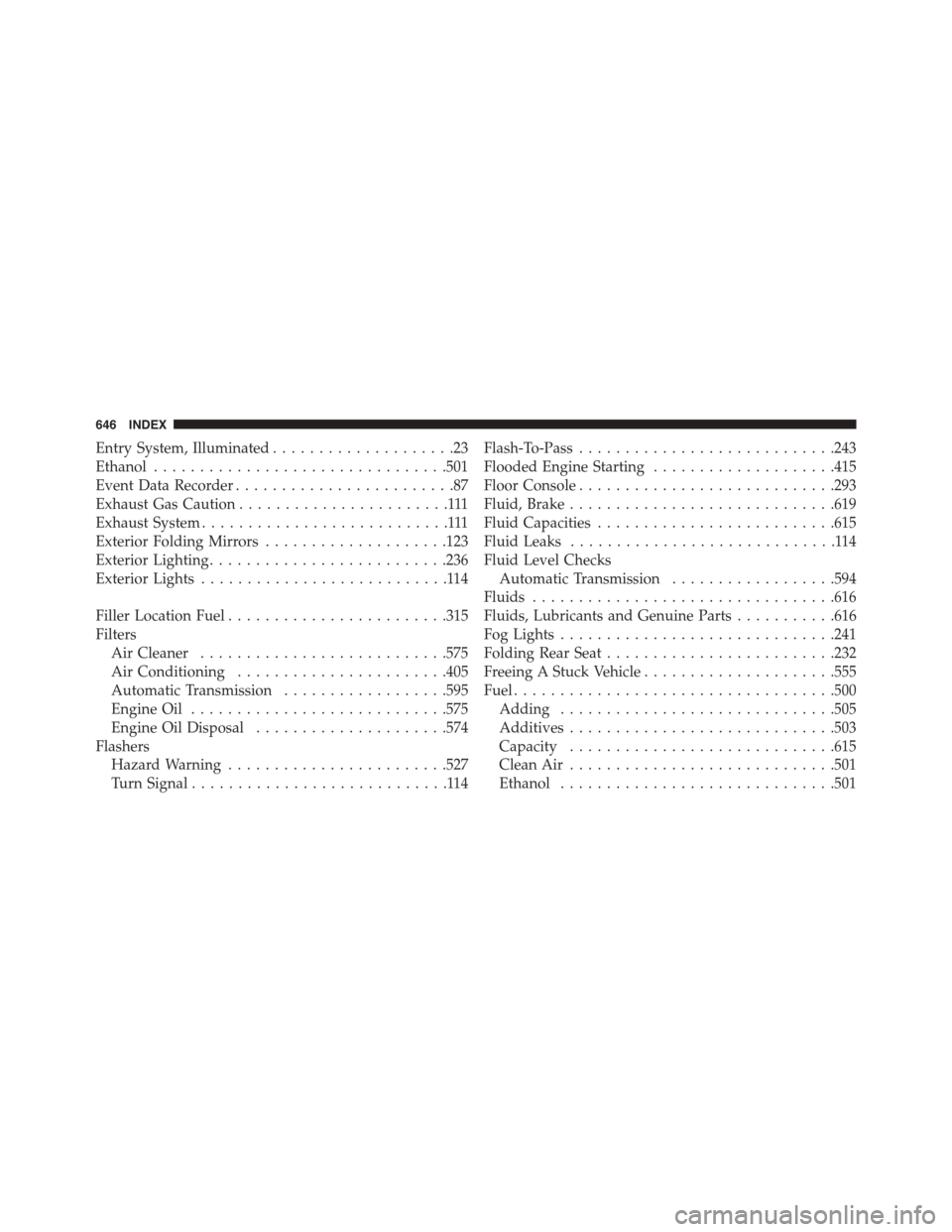
Entry System, Illuminated....................23
Ethanol................................501
Event Data Recorder........................87
Exhaust Gas Caution.......................111
Exhaust System...........................111
Exterior Folding Mirrors....................123
Exterior Lighting..........................236
Exterior Lights...........................114
Filler Location Fuel........................315
Filters
Air Cleaner...........................575
Air Conditioning.......................405
Automatic Transmission..................595
Engine Oil............................575
Engine Oil Disposal.....................574
Flashers
Hazard Warning........................527
Turn Signal............................114
Flash-To-Pass............................243
Flooded Engine Starting....................415
Floor Console............................293
Fluid, Brake.............................619
Fluid Capacities..........................615
Fluid Leaks.............................114
Fluid Level Checks
Automatic Transmission..................594
Fluids.................................616
Fluids, Lubricants and Genuine Parts...........616
Fog Lights..............................241
Folding Rear Seat.........................232
Freeing A Stuck Vehicle.....................555
Fuel...................................500
Adding..............................505
Additives.............................503
Capacity.............................615
Clean Air.............................501
Ethanol..............................501
646 INDEX